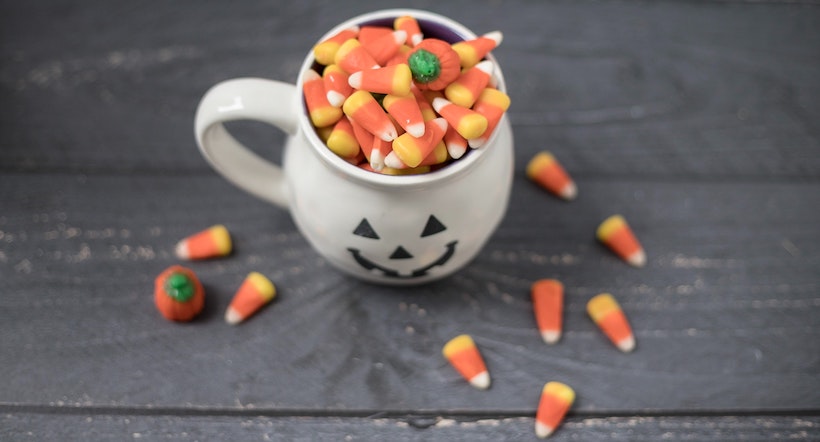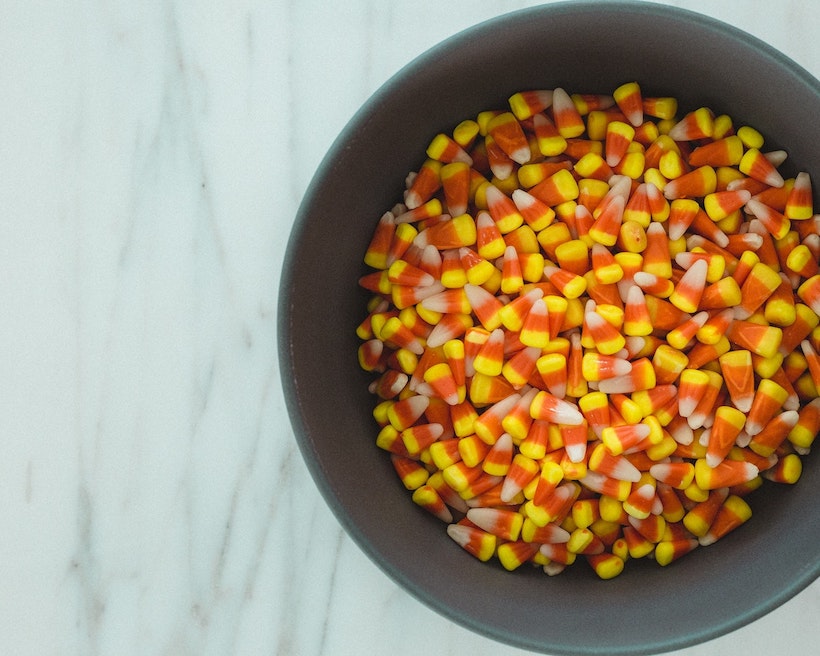Few candies are as polarizing as candy corn. As it begins to appear on shelves each October, most people have one of two reactions:
A controversial candy? That's right, and that's interesting – and it's why I wanted to delve into candy corn's history. Here's what I learned.

In the late 1800s, candy companies began experimenting with mixing sugar and corn syrup to create interesting new confections. At that time, the process took quite some time since it all had to be done by hand. These sweets would combine the two ingredients into a semi-liquid state called a slurry, add food coloring, and pour it into molds.
This concoction is called "mellowcreme" or "mellow creme." Originally, mellowcreme candies were only one color. Some of candy corn's mellowcreme precursors included monochromatic turnips, chestnuts, and pumpkins. Of the many contenders for the king of the mellowcream candies, candy corn (and its variants) – and pumpkins – are most popularly seen in stores today.
What set candy corn apart from the other mellowcreme candies? The innovation of adding a whopping three colors to the candy mix – by default, yellow, orange, and white – each one carefully layered by hand.
Most sources say that a man named George Renninger in the 1880s first invented the tri-color treat. Renninger worked at Wunderle Candy Company in Philadelphia and brought the idea to its founder, Philip Wunderle, and candy corn was born.
Despite Wunderle being credited with creating candy corn, it's early popularity arose due to the Goelitz Candy Company (now Jelly Belly Candy Company). Jelly Belly and another company, Brach's Candy, are two of the primary producers of candy corn today.
It took a while for people to begin calling this iconic candy by its current name. At first, candy corn was called "chicken feed"(!)
Why did candy corn start with such a name? In the early 1900s, most Americans were farmers, and many treats were made with that heritage in mind.
Farm animals were the primary consumers of corn at the turn of the 20th century, not humans. Many of the tasty corn hybrids people eat today did not exist yet. Because people often thought of corn as food for chickens, calling candy corn "chicken feed" made sense.
Also interesting, throughout the 1900s, "chicken feed" was associated with penny candy.
Remember the big metal scoopers at the candy store you used to fill up a bag with different small candies? Some people still call this penny candy – even though it costs far more than a penny for a bag now. But historically, children could go to the store with just a penny or a nickel and fill up a bag with candy corn and similar treats.
During this time, candy corn had yet to become associated with the fall season. During its penny candy years and for a few decades after, it was available year-round. In fact, in as late as the 1950s, Brach's Candy marketed candy corn as one of its "Summertime Candies."

Candy corn became known as a fall treat around the 1950s or so. One hypothesis for why? There was only a limited amount of machinery out there to make mellowcreme candy, and there was simply no capacity to produce candy corn year-round anymore. Either way, it became standard to reserve candy corn production for the period from August to November.
Also, candy corn rose in popularity for fall in conjunction with the spread of trick-or-treating. Relatedly – did you know that candy was not associated with Halloween until the 1950s?
According to media reports at the time, neighborhood trick-or-treating began in the 1930s but didn't really become popular until the 1950s. And when candy became a big part of Halloween, candy corn was a natural favorite. Its white, orange, and yellow stripes made it a perfect fit for the season.
For the past several decades, candy corn has been mass-produced rather than layered and made by hand. First, cornstarch – which maintains the shape of the candy – is poured into the molds.
Then, sugary liquids are added color by color. The white is poured in first, then the orange, then the yellow.
After setting in the mold for about a day, the candy is popped out then glazed for its trademark shine.
When it was made by hand, the process was arduous. Candy company employees had to walk forward and backward as they manually poured the slurry into trays, doing each colorful layer at a time.
It's a good thing it's all automated now – companies would not be able to keep up with the demand for the candy each October. According to a representative from the National Confectioners Association, approximately 35 million pounds of candy corn are made each year!
Although candy corn's ingredients have primarily remained the same over time, there have been a few small changes. Originally, candy corn was made with just sugar, corn syrup, marshmallow, and dyes, and that recipe remains similar in today's production of the treat.
Candy corn is tied to one of the earliest large food recalls in the United States. Today, its coloring comes from Yellow 6, Yellow 5, and Red 3 dyes. However, before the 1950s, Orange dye No. 1 was used as well.
Candy companies primarily stopped using Orange dye No. 1 after it was reported to cause illness in children post-Halloween in 1950. Modern Candy companies still avoid using Orange dye No. 1.

According to the National Confectioners Association, candy corn ranks second in a roundup of the most popular Halloween candy. Chocolate comes in first at 72%, and candy corn grabs 12% of Americans' votes. Despite this, several states rank candy corn as their number one favorite candy.
One thing's for sure – people love to argue about candy corn. And like any good controversial food (like conversation candy hearts!), that argument has leaked into popular culture.
In 2010, candy scholar (what a great job!) Samira Kawash wrote about its controversial nature. And those arguments she surfaced have, if anything, only got more intense.
Famously, Twitter fights happen every September and October as the corn hits the shelves. Here's a great example of the genre:
But perhaps most famously of all, comedian Lewis Black absolutely ripped the candy in an oft-quoted standup joke:
Corn that tastes like candy, indeed!
Fake recipes abound on the internet – and sometimes people create recipes to get a rise out of others. Sometimes, they make recipes earnestly, though, even if not targeting a superb meal!
Over time, candy corn fans and companies alike have come up with some pretty unique recipes that incorporate the controversial candy. Some individuals have created candy corn desserts, and now deep-fried candy corn has been gaining popularity, too.
On the commercial side, candy corn is going strong. Stores now feature candy corn-flavored Oreos, M&Ms, and other snacks. There is even a candy corn beer!
In one of the most controversial options yet, Brach's introduced a new flavoring for candy corn: Turkey Dinner Candy Corn, one that has the savory taste of a Thanksgiving dinner. (I'm not sure if I'll be giving that one a try!)
Candy corn stays fresh in a sealed bag for about nine months. It can keep in an opened bag for 3 to 6 months.
There is no right way to eat candy corn, but people have extremely strong opinions on the topic.
One report says that 58% of people eat a piece of the candy whole, 29% eat it from the narrow white end, and 13% eat it starting from the yellow bottom end.
National Candy Corn Day is on October 30.
The main two ingredients in Brach's candy corn recipe are sugar and corn syrup.
The serving size is 15 pieces. In a serving, there are 110 calories, 0 grams of fat, and 22 grams of sugar.
Recently, companies have created candy corn spinoffs for other holidays, including Easter, Valentine's Day, and Christmas, with different colors for each holiday. Companies have also introduced a few new flavors, such as peppermint and pumpkin spice.
The most popular autumn variety is harvest corn, which has a brown base mixed with cocoa powder. Pumpkin mellowcreme candy is also enjoyed by many who can't resist the pumpkin flavor.

To be honest, I'm not quite decided on candy corn. As a kid, I certainly ate too much a few times only to be left with a huge stomachache (and a sugar rush, haha). But – I love to have the option to pick up a bag.
Candy corn, for all its controversies, has stood the test of time. Whether in chicken feed form, in its stint as penny candy, or as today's most controversial Halloween candy, candy corn is pretty sweet.